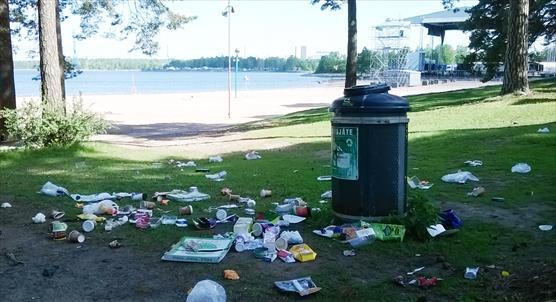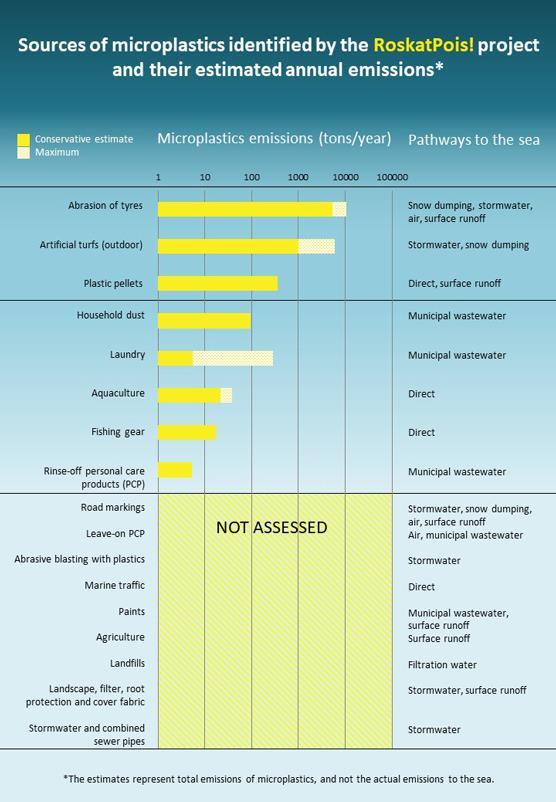Press release 2020-03-24 at 9:00
A report compiled by the Finnish Environment Institute SYKE has produced a clearer picture of litter in the Finnish marine environment. On beaches close to residential areas 90% of the litter visible to the naked eye is composed of various plastic and foam plastic products, and cigarette butts are the most common type of plastic waste. Road traffic is the most significant source of microplastics.

On urban beaches the majority (70–80%) of the litter is estimated to originate from the land (recreational beach use, urban storm water, construction and fly tipping). © Outi Setälä
Litter is one of the most threatening problems facing the global marine environment. However, there has not been sufficient information about littering in the Finnish marine environment in order to be able to plan measures to mitigate it. A report published by SYKE evaluated the amounts, quality, sources and pathways of all sizes of marine litter in all Finnish beach and sea areas.
Litter visible to the naked eye, i.e. macro-litter was monitored on different types of beaches. The results show that Finnish beaches have an average of 240 pieces of litter per thousand square metres.
“Amounts of litter are smaller on beaches in their natural state and higher on urban beaches. About 90% of beach litter is composed of various plastic or foam plastic products. On urban beaches almost 70% of all the litter is cigarette butts, while on more rural beaches they make up about 5% of litter,” explains senior researcher Sanna Suikkanen from SYKE.
Almost half of the rest of the beach litter is made up of unidentifiable shreds of plastic. On urban beaches the majority (70–80%) of the litter is estimated to originate from the land (recreational beach use, urban storm water, construction and fly tipping). On more rural beaches about 60% of the litter is estimated to originate from the land and 40% from the sea, marine traffic and fishing.
Storm water an important route
Responses to a survey sent to environmental experts in coastal towns emphasised the importance of storm water as a pathway for litter. Other factors raised as causing littering were overflowing drains, illegal fly-tipping, piles of snow from ploughing the streets and its disposal, insufficient litter bins and various construction and demolition work.
“Research and monitoring methods for microscopically small plastic litter, i.e. microplastics, are under development but no harmonised guidance on these is available yet. Based on the data gathered from Finland’s sea areas so far, there are more microplastics in coastal waters than in the open sea,” says leading researcher Outi Setälä from SYKE.
The sources of microplastics were evaluated with the help of available information about consumption habits, production processes, breakdown of materials and material flows. The report sought to take into account the sources of microplastics that have been found significant in corresponding assessments made in other countries.

© Finnish Environment Institute SYKE
Microplastic emissions from cosmetics and hygiene products small compared to other sources
The results show that road traffic is the single most significant source of microplastics in Finland. Wear of vehicle tyres causes about 5,000–10,000 tonnes of microplastic pollution every year. Rubber crumb, used as a filler in artificial grass, is being added on the pitches by about 1,000–6,000 tonnes annually, but because part of the additional need is caused by the filler compacting over time, this figure does not unequivocally depict the amount of rubber crumb that ends up in the environment. Plastic pellets, the raw material in plastic products, are estimated to cause about 360 tonnes of microplastic emissions a year. The maximum estimate of microplastic emissions caused by washing artificial fibre textiles (290 tonnes/year) is on the same scale. The microplastic emission caused by rinse-off personal care products (approximately 5 tonnes/year) is smaller than other sources of pollution.
When operating without disruption, modern wastewater treatment plants in Finland efficiently remove microplastic in community wastewater. According to studies, only a few percent of plastic emissions caused by textile laundry and personal care products ultimately ends up in the receiving watercourses. When examining sea-based sources of marine litter, there was a focus on microplastic emissions caused by fishing and aquaculture. It is estimated that at most 17 tonnes of microplastics annually come from equipment used in commercial fishing in Finnish waters and 30 tonnes from structural materials in aquaculture.
The report on the sources of marine litter in Finnish waters was funded by the European Maritime and Fisheries Fund. The report was produced by the Finnish Environment Institute (SYKE) in partnership with the Natural Resources Institute Finland (Luke) and the Finnish Transport and Communications Agency (Traficom).
Further information
Leading researcher Outi Setälä, tel. +358 295 251 635 (microplastics, marine litter), firstname.lastname@ymparisto.fi
Senior researcher Sanna Suikkanen, tel. +358 295 251 660 (macrolitter), firstname.lastname@ymparisto.fi
Link to the report (includes abstract in English):
Suomen merialueen roskaantumisen lähteet, Suomen ympäristökeskuksen raportteja 9/2020
www.syke.fi/meriroskat